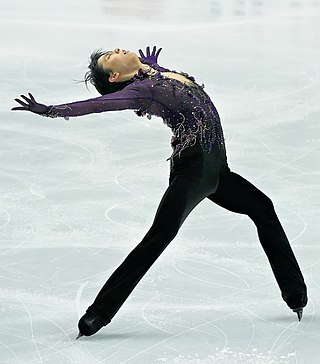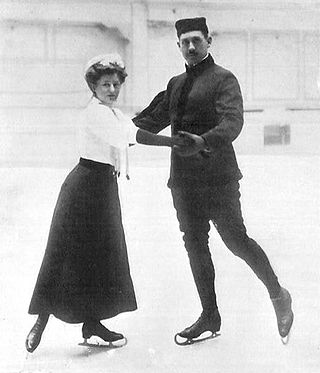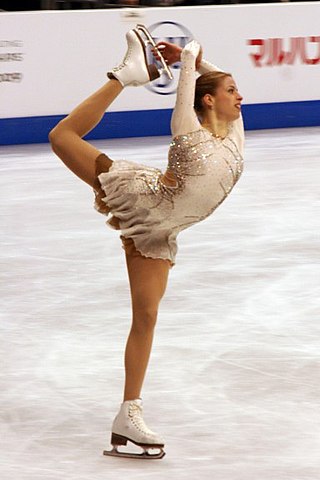
Figure skating is a sport in which individuals, pairs, or groups perform on figure skates on ice. It was the first winter sport to be included in the Olympic Games, when it was contested at the 1908 Olympics in London. The Olympic disciplines are men's singles, women's singles, pair skating, and ice dance; the four individual disciplines are also combined into a team event, which was first included in the Winter Olympics in 2014. The non-Olympic disciplines include synchronized skating, Theater on Ice, and four skating. From intermediate through senior-level competition, skaters generally perform two programs, which, depending on the discipline, may include spins, jumps, moves in the field, lifts, throw jumps, death spirals, and other elements or moves.
Figure skating jumps are an element of three competitive figure skating disciplines: men's singles, women's singles, and pair skating – but not ice dancing. Jumping in figure skating is "relatively recent". They were originally individual compulsory figures, and sometimes special figures; many jumps were named after the skaters who invented them or from the figures from which they were developed. It was not until the early part of the 20th century, well after the establishment of organized skating competitions, when jumps with the potential of being completed with multiple revolutions were invented and when jumps were formally categorized. In the 1920s Austrian skaters began to perform the first double jumps in practice. Skaters experimented with jumps, and by the end of the period, the modern repertoire of jumps had been developed. Jumps did not have a major role in free skating programs during international competitions until the 1930s. During the post-war period and into the 1950s and early 1960s, triple jumps became more common for both male and female skaters, and a full repertoire of two-revolution jumps had been fully developed. In the 1980s men were expected to complete four or five difficult triple jumps, and women had to perform the easier triples. By the 1990s, after compulsory figures were removed from competitions, multi-revolution jumps became more important in figure skating.

Spins are an element in figure skating in which the skater rotates, centered on a single point on the ice, while holding one or more body positions. They are performed by all disciplines of the sport, single skating, pair skating, and ice dance, and are a required element in most figure skating competitions. As The New York Times says, "While jumps look like sport, spins look more like art. While jumps provide the suspense, spins provide the scenery, but there is so much more to the scenery than most viewers have time or means to grasp". According to world champion and figure skating commentator Scott Hamilton, spins are often used "as breathing points or transitions to bigger things"

Compulsory figures or school figures were formerly a segment of figure skating, and gave the sport its name. They are the "circular patterns which skaters trace on the ice to demonstrate skill in placing clean turns evenly on round circles". For approximately the first 50 years of figure skating as a sport, until 1947, compulsory figures made up 60 percent of the total score at most competitions around the world. These figures continued to dominate the sport, although they steadily declined in importance, until the International Skating Union (ISU) voted to discontinue them as a part of competitions in 1990. Learning and training in compulsory figures instilled discipline and control; some in the figure skating community considered them necessary to teach skaters basic skills. Skaters would train for hours to learn and execute them well, and competing and judging figures would often take up to eight hours during competitions.
The Lutz is a figure skating jump, named after Alois Lutz, an Austrian skater who performed it in 1913. It is a toepick-assisted jump with an entrance from a back outside edge and landing on the back outside edge of the opposite foot. It is the most difficult jump and the second-most famous jump after the Axel.
The toe loop jump is the simplest jump in the sport of figure skating. It was invented in the 1920s by American professional figure skater Bruce Mapes. The toe loop is accomplished with a forward approach on the inside edge of the blade; the skater then switches to a backward-facing position before their takeoff, which is accomplished from the skater's right back outside edge and left toepick. The jump is exited from the back outside edge of the same foot. It is often added to more difficult jumps during combinations and is the most common second jump performed in combinations. It is also the most commonly attempted jump.
The flip jump is a figure skating jump.
A layback spin is a variation of the upright spin, a spin in figure skating. British figure skater Cecilia Colledge was "responsible for the invention" of the spin and the first to execute it. Colledge's coach, Jacques Gerschwiler, who was a former gymnastics teacher and according to Colledge "very progressive in his ideas", got the idea for the upright spin while watching one of Colledge's trainers, a former circus performer turned acrobatics instructor, train Colledge to perform backbends "by means of a rope tied around her waist". The upright spin has long been associated with women's skating, but men have also performed it. Skaters include it in their programs because it increases their technical content and fulfills choreographic needs.
The loop jump is an edge jump in the sport of figure skating. The skater executes it by taking off from the back outside edge of the skating foot, turning one rotation in the air, and landing on the back outside edge of the same foot. It is often performed as the second jump in a combination.

Pair skating is a figure skating discipline defined by the International Skating Union (ISU) as "the skating of two persons in unison who perform their movements in such harmony with each other as to give the impression of genuine Pair Skating as compared with independent Single Skating". The ISU also states that a pairs team consists of "one Woman and one Man". Pair skating, along with men's and women's single skating, has been an Olympic discipline since figure skating, the oldest Winter Olympic sport, was introduced at the 1908 Summer Olympics in London. The ISU World Figure Skating Championships introduced pair skating in 1908.

The camel spin is one of the three basic figure skating spin positions. British figure skater Cecilia Colledge was the first to perform it. The camel spin, for the first ten years after it was created, was performed mostly by women, although American skater Dick Button performed the first forward camel spin, a variation of the camel spin, and made it a regular part of the repertoire performed by male skaters. The camel spin is executed on one foot, and is an adaptation of the ballet pose the arabesque to the ice. When the camel spin is executed well, the stretch of the skater's body creates a slight arch or straight line. Skaters increase the difficulty of camel spins in a variety of ways.
The following is a glossary of figure skating terms, sorted alphabetically.

Single skating is a discipline of figure skating in which male and female skaters compete individually. Men's singles and women's singles are governed by the International Skating Union (ISU). Figure skating is the oldest winter sport contested at the Olympics, with men's and women's single skating appearing as two of the four figure skating events at the London Games in 1908.
The short program of figure skating is the first of two segments of competitions, skated before the free skating program. It lasts, for both senior and junior singles and pair skaters, 2 minutes and 40 seconds. In synchronized skating, for both juniors and seniors, the short program lasts 2 minutes and 50 seconds. Vocal music with lyrics is allowed for all disciplines since the 2014-2015 season. The short program for single skaters and for pair skaters consists of seven required elements, and there are six required elements for synchronized skaters.
The 6.0 system of judging figure skating was developed during the early days of the sport, when early international competitions consisted of only compulsory figures. Skaters performed each figure three times on each foot, for a total of six, which as writer Ellyn Kestnbaum states, "gave rise to the system of awarding marks based on a standard of 6.0 as perfection". It was used in competitive figure skating until 2004, when it was replaced by the ISU Judging System in international competitions, as a result of the 2002 Winter Olympics figure skating scandal. British ice dancers Jayne Torvill and Christopher Dean earned the most overall 6.0s in ice dance, Midori Ito from Japan has the most 6.0s in single skating, and Irina Rodnina from Russia, with two different partners, has the most 6.0s in pair skating.

Figure skating lifts are required elements in two disciplines of figure skating, pair skating and ice dance. There are five groups of lifts in pair skating, categorized in order of increasing level of difficulty. Judges look for the following when evaluating pair lifts: speed of entry and exit; control of the woman's free leg when she is exiting out of the lift, with the goal of keeping the leg high and sweeping; the position of the woman in the air; the man's footwork; quick and easy changes of position; and the maintenance of flow throughout the lift. Twist lifts are "the most thrilling and exciting component in pair skating". They can also be the most difficult movement to perform correctly. They require more strength and coordination than many other pair elements, and are usually the first or second element in a program. According to the International Skating Union (ISU), "the Woman must be caught in the air at the waist by the Man prior to landing and be assisted to a smooth landing on the ice on a backward outside edge on one foot" during a twist lift. A pair lift and twist lift is required in the short program of pair skating; a well-balanced free skating program in pair skating must include lifts.

A quadruple jump or quad is a figure skating jump with at least four revolutions. All quadruple jumps have four revolutions, except for the quadruple Axel, which has four and a half revolutions. The quadruple toe loop and quadruple Salchow are the two most commonly performed quads. Quadruple jumps have become increasingly common among World and Olympic level men's single skaters, to the point that not performing a quad in a program has come to be seen as a severe handicap. This phenomenon is often referred to as the "quad revolution". Since 2018, quadruple jumps have also become an increasingly common feature of women's skating, although they are not allowed under the International Skating Union ("ISU") rules in the ladies' short program. The first person to land a ratified quadruple jump in competition was Canadian Kurt Browning in 1988. Japanese skater Miki Ando became the first female to do so, in 2002.
British Ice Skating is the national governing body of ice skating within the United Kingdom. Formed in 1879, it is responsible for overseeing all disciplines of ice skating: figure skating ; synchronised skating; and speed skating.
The upright spin is one of the three basic figure skating spin positions. The International Skating Union (ISU), the governing body of figure skating, defines an upright spin as a spin with "any position with the skating leg extended or slightly bent which is not a camel position". It was invented by British figure skater Cecilia Colledge. Variations of the upright spin include the layback spin, the Biellmann spin, the full layback, the split, the back upright spin, the forward upright spin, the scratchspin, and the sideways leaning spin.
The Axel jump or Axel Paulsen jump, named after its inventor, Norwegian figure skater Axel Paulsen, is an edge jump performed in figure skating. It is the sport's oldest and most difficult jump, and the only basic jump in competition with a forward take-off, which makes it the easiest to identify. A double or triple Axel is required in both the short program and the free skating segment for junior and senior single skaters in all events sanctioned by the International Skating Union (ISU).









